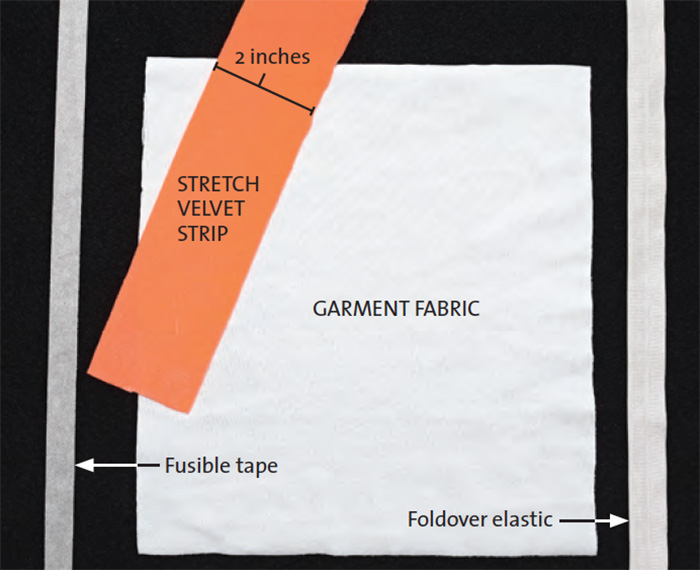
Outlining the contours of a stretch garment adds decorative impact. You can do this without compromising the garment’s flexibility, with an applied band that remains smooth and ripple-free. This technique, detailed below, uses 1/2-inch-wide fusible tape to stabilize the band. You’ll learn how to apply a stretch velvet edging to a smooth, spandex-blend knit fabric. The edge is then bound with foldover elastic.
1. Cut the fabrics
Make the band the desired finished width, plus the width of the fusible tape. For this sample, I cut a 2-inch-wide stretch velvet strip, to apply to a spandex-blend garment fabric, which I cut with its edge on the straight grain.
Be sure to cut the band with the nap in the direction that is appropriate for its final position on the garment. A bias strip may lie flatter on the body.
2. Apply fusible tape to the velvet strip
Align a 1/2-inch-wide fusible tape’s sticky side to one long edge of the velvet edging strip’s wrong side . With an iron on the synthetic setting and using a press cloth—a must when working with synthetics—lightly press the iron along the paper backing to fuse the tape. Peel off the paper.
3. Fuse the velvet strip’s edge
Gently fold over the fused edge by the width of the tape. Press to secure the folded edge. This helps reduce the stretching while sewing and creates a sharp edge.
4. Attach the fused edging to the fabric
With both fabrics right side up, align the velvet strip’s raw edge along the garment edge. Pin at 1-inch intervals. Zigzag 1/4 inch from the edge. (Contrasting thread was used in the samples for visibility.) Avoid stretching the fabrics while stitching. Press lightly.
5. Pin and stitch the velvet’s fused edge to the garment
Pin at 1-inch intervals and then straight-stitch the fused edge 1/8 inch from the fold. I set the stitch length to 2.5 mm to 3.0 mm. Press lightly.
6. Apply foldover elastic
To cover the raw edges with the elastic, first pin or baste its end to the garment edge. Then gently pull the elastic toward you as you fold and zigzag. Note: Practice folding and stitching on a sample to familiarize yourself with the process.




































Where do you get stretch velvet? Can you show a picture of the finished look in the total garment please.
Yes, would like to see some examples for inspiration.
A picture of the finished garment is needed here in order to understand where the band is being applied. I assume it's being applied at the hem (edging?), but the text does not specifiy and the photos only show the band placed vertically.
Unfortunately, we don't have a photo of a finished garment with this treatment to share with you. We invite you to use your imagination to consider where you might like a smooth, contrast band on a garment. Erin Jean uses this technique on ballroom dance costumes, but it would work just as well on activewear or casual garments. It's suitable for fabric cut on the straight or crossgrain, and I think would work on bias-cut knits as well if you handle them carefully.
Carol Fresia, Senior Technical Editor
Thanks for your response!
I'm still a little confused, but this sounds like a great tip. The orange velvet strip must show up on the outside of the cuff(?) or edge, but I don't get what the elastic edge looks like. Can you use the method and create a real life example for us?